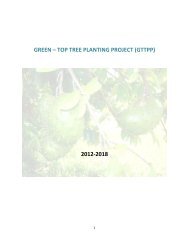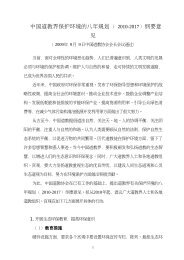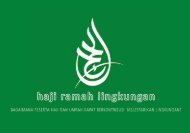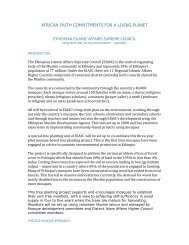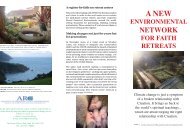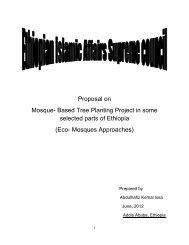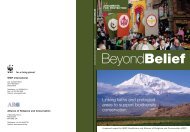summary paper - Alliance of Religions and Conservation
summary paper - Alliance of Religions and Conservation
summary paper - Alliance of Religions and Conservation
You also want an ePaper? Increase the reach of your titles
YUMPU automatically turns print PDFs into web optimized ePapers that Google loves.
transparency <strong>and</strong> equality, rather that the transparency was one sided from their part. There existed a<br />
paternalism <strong>of</strong> partnership.<br />
Experiences <strong>of</strong> inequality on the one h<strong>and</strong> <strong>and</strong> dominance from the donor part on the other form the basis<br />
<strong>of</strong> the criteria for partnership worked out by Christian <strong>and</strong> Muslim faith communities presented to us by<br />
the <strong>Alliance</strong> <strong>of</strong> <strong>Religions</strong> <strong>and</strong> <strong>Conservation</strong> (ARC). Recognizing that religious communities <strong>and</strong> faithbased<br />
groups play an important role in many peoples´ lives <strong>and</strong> in society <strong>and</strong> therefore “could bring to<br />
bear relevant traditions, teachings, <strong>and</strong> underst<strong>and</strong>ings <strong>of</strong> our relationship with the environment <strong>and</strong><br />
human development”, as is stated in the conference presentation, ARC works out from the presumption<br />
that the faith communities are relevant partners to major economical institutions as the World Bank <strong>and</strong><br />
states like the Norwegian. But is this true And: If so, what are the costs <strong>of</strong> such partnership given the<br />
criteria presented to us by ARC (I must here confess that my presentation is based on the Muslim <strong>and</strong><br />
Christian criteria, because I only got the Buddhist yesterday here at the conference, but I do not think that<br />
that would change my main conclusion).<br />
The presumed context <strong>of</strong> power that is at the bottom <strong>of</strong> the criteria is the one between donor <strong>and</strong> receiver,<br />
between a “North” <strong>and</strong> a “South”. As a discussion <strong>of</strong> power within partnership this is important, but not<br />
enough. It is not adequate to discuss power in a NorthSouth perspective addressing the issues <strong>of</strong><br />
political <strong>and</strong> economical power <strong>and</strong> inequality, when at the same time leaving out probably the main<br />
conflict <strong>of</strong> power related to religion, <strong>and</strong> that is gender. The criteria presented are mostly gender blind, or<br />
at best I would say that they are gender blind, though I suspect that it is not blindness but rather<br />
awareness <strong>of</strong> this problem that has resulted in the lack <strong>of</strong> gender or reference to women in the criteria.<br />
The potential conflict in partnership not talked about neither in the Muslim <strong>and</strong> Christian criteria nor in the<br />
conference presentation <strong>and</strong> hardly in the discussions we have had so far, is the conflict between religion,<br />
gender <strong>and</strong> power. More precisely it is the problem <strong>of</strong> human rights <strong>and</strong> gender equality. There has been<br />
a mentioning <strong>of</strong> human rights as being central to partnership, but what does that mean for women Does<br />
it also apply to them These are troublesome questions, but they need to be asked.<br />
With very few exceptions, the norm within all the world religions is that a gender based hierarchy <strong>and</strong><br />
segregation are constitutive to the religious <strong>and</strong> social order. Women are neither seen nor related to as<br />
equal to men nor having the same rights. When ARC therefore introduces to us partnership criteria that<br />
states that “existing structure <strong>of</strong> the community should be respected <strong>and</strong> underlined”, as said in the<br />
Muslim criteria, I think this ought to challenge the World Bank, UNDP or the Norwegian government,<br />
because what does such a statement mean from a gender perspective As most existing structures in a<br />
community are male dominated, one consequence <strong>of</strong> entering into a partnership with a religious<br />
community based on such a criteria, would in most cases mean accepting <strong>and</strong> supporting faith based<br />
discrimination <strong>of</strong> women. That would contradict one core value within for example the Norwegian<br />
government, namely womens ´ human rights <strong>and</strong> equality to men. It would violate the human rights <strong>of</strong><br />
women. It would lead to a strengthening <strong>of</strong> the power <strong>of</strong> those already in power. Is equality <strong>of</strong> women<br />
something that is negotiable whereas male domination is not This is an important question to raise in<br />
order to<br />
I am not suggesting that gender segregated communities can not form a basis for development <strong>and</strong><br />
environmental projects. But when such projects are performed within a community based on gendered<br />
hierarchy <strong>and</strong> segregation these projects will remain outside the realm <strong>of</strong> power, the project <strong>and</strong> their<br />
women being the constant other (cf the presentation by MarjaLiisa Swantz). Very <strong>of</strong>ten good projects run<br />
by <strong>and</strong> very <strong>of</strong>ten for women (or children or elderly), are fundamental to the livelihood <strong>of</strong> the community<br />
they live in. But these same projects are seldom accounted for <strong>and</strong> do even more seldom challenge the<br />
power structure. As a consequence women´s work load <strong>of</strong>ten increases without increasing their rights.<br />
One example could be the important work <strong>of</strong> care for HIV/Aids infected <strong>and</strong> affected that many women<br />
perform. This is fundamental to the communities, but it very <strong>of</strong>te takes place in a form that simply confirms<br />
the segregation between men <strong>and</strong> women: Women become the caring mothers for all the sick or affected<br />
in a community, but their right to their own sexuality, the right to say no to sex with a man or even their<br />
husb<strong>and</strong>, is denied them. 23 It is therefore not enough to discuss power as a NorthSouth question. When<br />
the issue is religious communities, power from a gender perspective has to be addressed.<br />
23<br />
The reason for taking up the issue <strong>of</strong> women´s rights to say no to their husb<strong>and</strong>s is the problem <strong>of</strong> HIV/Aids<br />
infecting faithful women through promiscuous husb<strong>and</strong>s.<br />
52



